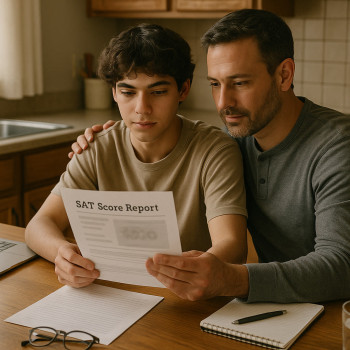Welcome: Why This Guide Matters Now
If you’re a parent reading this, you’re probably juggling schedules, emails from counselors, and a teenager who alternates between calm focus and sudden existential dread about the future. You’re not alone. The college application process has evolved — the SAT has gone digital, many colleges emphasize a holistic review, and admissions officers look for more than just test scores. This guide is written for families who want to pair thoughtful, effective Digital SAT preparation with a broader strategy that tells a student’s whole story.

Understanding the Landscape: Digital SAT and Holistic Admissions
Start here: the SAT still matters for many colleges, but it is only one piece of a larger puzzle. With the College Board’s shift to a digital format, the testing experience is shorter and adaptive, and score reports now include richer insights into content-area strengths. At the same time, many institutions now explicitly review transcripts, essays, recommendation letters, extracurricular depth, demonstrated interest, and personal background. For parents, that means balancing test prep with long-term development.
What the Digital SAT change means for families
- Shorter, adaptive test — fewer questions but different scoring dynamics; pacing and comfort with the test app are key.
- Score reports are more diagnostic — you’ll see strengths by content area that can steer practice more effectively.
- Testing logistics shifted — schools may offer in-school administrations, and personal weekend testing may differ in availability. Keep communication open with your student’s counselor.
- Prep resources like Official Digital SAT practice on Khan Academy, Bluebook previews, and targeted tutoring remain valuable.
Holistic review — what admissions officers actually want
Colleges seek students who will contribute academically and personally to campus life. That translates into several recurring themes:
- Academic rigor and trajectory: Challenging courses and improvement over time.
- Intellectual curiosity: Projects, research, or pursuits that show depth.
- Character and resilience: How a student responds to setbacks matters.
- Fit and contribution: Activities and experiences that indicate how a student will participate on campus.
- Clear, authentic narrative: Essays and recommendations that help reviewers understand the student’s voice and goals.
Start with a Plan: A Family-Friendly Application Timeline
Mapping the journey reduces stress. Below is a practical high-level timeline you can adapt to your student’s grade level and ambitions. Turn it into a shared Google Calendar or a wall chart in your home.
| When | Focus | Family Actions |
|---|---|---|
| 9th Grade | Exploration & Foundations | Encourage curiosity; build study habits; explore clubs & hobbies. |
| 10th Grade | Skill growth & exploratory testing | Consider PSAT; start test practice; deepen 1–2 activities. |
| 11th Grade | Application readiness & testing | Take digital SAT (or PSAT/NMSQT), meet with counselor, begin brainstorming essays. |
| Summer before Senior Year | Finalize story & applications | Visit campuses (or virtual tours), draft essays, request recommendations. |
| Senior Year | Apply & celebrate | Polish applications, confirm test sends if required, keep grades strong. |
Quick tip
Set milestones no smaller than two weeks (e.g., “first essay draft by April 15”) so progress is visible and pressure stays manageable.
Building the Holistic Application Components
Think of the application as a mosaic. Each piece — transcript, tests, extracurriculars, essays, recommendations, and interviews — contributes color, texture, and meaning. Below we break down practical ways to strengthen each component without exhausting your student.
1. Academic Record: Grades, courses, and trajectory
Colleges value the pattern: Did your student push themselves? Did they show resilience and improvement? Families can help by:
- Encouraging a balance between challenge and well-being — one more AP or honors course is great if your student can handle it without burnout.
- Tracking trends — a rising GPA often speaks louder than one perfect semester followed by a drop.
- Communicating with teachers early if a class becomes overwhelming — interventions like tutoring, modified loads, or summer catch-up can be lifesavers.
2. Digital SAT: Preparation that complements the whole profile
Prep is practical: familiarize your student with the adaptive format, timing, and digital tools (like the built-in calculator). But don’t let the SAT eclipse everything else. Smart test prep strategies:
- Start with a diagnostic test to identify weak areas, then focus practice there — quality beats quantity.
- Use timed digital practice under Bluebook-like conditions to build comfort with the interface and pacing.
- Integrate reading widely and practicing math problem-solving as daily habits rather than isolated cram sessions.
- Consider targeted 1-on-1 tutoring for stickier skill gaps; personalized tutoring (such as Sparkl’s 1-on-1 guidance and tailored study plans) can quickly convert weaknesses into reliable skills.
3. Extracurriculars: Depth beats a long list
Admissions officers look for meaningful commitment. A few sustained, passionate activities are more persuasive than many shallow experiences. Help your student by asking questions like:
- Which activities have they returned to year after year?
- Where have they taken leadership or tangible initiative?
- What projects show curiosity or impact, even in small communities?
Encourage reflection — a short journal entry after meaningful activities helps later when writing essays and building resumes.
4. Personal Essays: The chance to tell the story only your student can tell
Essays are where a student’s voice and perspective shine. Parents should act as editors and coaches, not authors. Ways to support:
- Help brainstorm specific anecdotes tied to growth rather than abstract praise.
- Ask honest questions about stakes, challenges, and learning: What changed for them? Why does this matter?
- Provide gentle feedback on clarity, specificity, and tone; avoid rewriting and instead prompt improved drafts.
- If your family chooses extra support, consider tutors with essay expertise who provide feedback while preserving the student’s voice. Personalized programs (like Sparkl’s expert tutors and AI-driven insights) can accelerate drafting and revision while keeping the essay authentic.
5. Recommendations: Building advocates
Great recommendations come from teachers or mentors who know the student well. Help your student by:
- Giving recommenders a reminder packet: resume, list of courses with grades, a short note about the student’s goals, and a deadline-friendly timeline.
- Encouraging students to meet with recommenders in person or virtually to refresh memories about meaningful classroom moments.
6. Interviews and Demonstrated Interest
Not all schools interview, but when they do, treat the interview as a conversation, not an interrogation. Practice common questions and emphasize curiosity. Demonstrated interest (visits, campus emails, thoughtful questions) can matter at some colleges — helping your student show fit, not desperation.
Practical Tools and Routines for Families
Routine beats panic. Parents can set structures that build momentum and reduce friction.
Weekly family check-ins
Ten to fifteen minutes once a week to review progress: upcoming deadlines, test practice minutes logged, counselor notes, and well-being. The goal: predictable accountability and emotional support.
Study plan framework
- Daily: 30–60 minutes of focused content practice (reading, math problems, or essay revision).
- Weekly: One timed practice test every 2–3 weeks when actively prepping for the Digital SAT.
- Monthly: Review extracurricular progress and update the activities resume.
Tools that simplify
- Shared calendar for deadlines (FAFSA, school applications, financial aid forms).
- Document folder for all application materials (transcript requests, counselor details, teacher recommender contacts).
- Practice test log to track improvement and target new goals.
Balancing Support and Independence
One of the trickiest parts is knowing when to step in. Students need scaffolding and the chance to own their process. A few guiding principles:
- Let them lead the narrative. Parents can edit tone and logistics, but the student’s voice must shine.
- Be a mirror, not a scriptwriter. Ask questions that reveal deeper reflections rather than offering answers.
- Normalize setbacks. Colleges value growth. A late grade, a dropped activity, or a disappointing practice test can become powerful context when reframed honestly.
Financial Aid and Scholarships: Where the SAT Fits
Many scholarships still use test scores as one criterion, but other metrics — GPA, leadership, community impact — also matter. Use BigFuture-style scholarship search strategies: widen the pool by applying to both small and large awards, and encourage students to look for local and school-based opportunities where competition may be lower.
Practical table: Scholarship search checklist
| Action | Why it helps | When to do it |
|---|---|---|
| Create a scholarship spreadsheet | Keeps deadlines and requirements organized | Summer before senior year |
| Apply to local community scholarships | Often less competition, quicker turnaround | Ongoing — monthly |
| Use test-optional strategies wisely | If scores strengthen an application, submit; if not, emphasize other strengths | When finalizing applications |
Real-World Examples: How a Holistic Application Comes Together
Example 1: The Curious Builder — A Middle-Tier Research University Fit
Sophia is a junior who loves mechanical design. Her Digital SAT scores are solid but not stellar. She spent summers building a community tool library and led a robotics club that mentored middle schoolers. Her essay ties a failed prototype to persistence and a refined design that later helped a neighbor with a mobility aid.
- Academic narrative: Strong upward trend in STEM courses.
- Activities: Depth in robotics and community impact.
- Test: Good enough to complement other strengths; targeted tutoring improved a math subscore.
- Result: A compelling application that shows fit for a hands-on engineering program.
Example 2: The Emerging Writer — A Liberal Arts College Fit
Jamir’s grades are consistent; his Digital SAT reading score is high. He edits the school literary magazine and started a neighborhood oral-history project. His essays show voice, empathy, and curiosity. He leveraged a recommendation from a creative writing teacher who could speak to his craft.
- Academic narrative: Consistent achievement with selective advanced humanities courses.
- Activities: Leadership in literary spaces and initiative with community storytelling.
- Test: Strong reading score helped unlock merit aid at some colleges.
When and How to Use Additional Help
There’s no shame in asking for help — tutoring, counseling, and application coaching can be game-changers when used thoughtfully. Consider professional support if:
- Your student struggles with subject-specific gaps that hurt GPA or test performance.
- Time management and organization repeatedly derail progress.
- You want a structured, individualized plan to balance testing and application work.
Look for services that emphasize personalization. For example, tutoring that offers 1-on-1 guidance, tailored study plans, and expert feedback (plus AI-driven practice analytics) can accelerate progress without erasing the student’s authentic voice.
Emotional Support: Keeping Well-Being at the Center
College admissions matter, but teenagers are people first. Sleep, movement, friendships, and joy fuel academic success. Families should:
- Prioritize routines that include downtime.
- Celebrate small wins — a better practice test, a polished essay draft, an insightful recommendation letter.
- Model perspective: remind your student that there are many paths to success and that college is a chapter, not the entire story.
Final Checklist: One Month Before Submissions
- Finalize essays and have a trusted reader check for clarity and authenticity.
- Confirm that recommenders have submitted letters.
- Verify transcript and test score sends (if required) with school counselor and the testing account.
- Complete FAFSA and any required financial aid forms the minute they open; don’t wait.
- Keep grades strong — senior-year performance is still read closely.

Parting Advice for Parents
Be patient and curious. Your job is to steward the process, not carry it. Ask encouraging questions, provide logistical support, and honor your student’s agency. Celebrate curiosity and persistence over perfection. The best applications don’t come from stress-fueled last-minute edits — they come from consistent habits, meaningful experiences, and honest reflection.
If targeted academic support feels right for your family — for example, improving a math subscore on the Digital SAT or polishing essays — look for personalized options that respect the student’s voice and learning style. Tutors and coaches who offer 1-on-1 guidance, tailored study plans, and expert feedback (including helpful analytics) can turn worry into progress and clarity. When chosen carefully and used sparingly, this help can keep college preparation balanced and sustainable.
Closing: The Bigger Picture
College admissions can feel like a high-stakes puzzle, but at the heart of it is a human story — who your student is, what they care about, and where they want to grow. The Digital SAT is a modern tool to demonstrate skills, but a thoughtful, holistic application shows context, curiosity, and contribution. As a parent, your steady presence, practical support, and belief in your child’s growth will be the most powerful elements in that story.
Take it one step at a time. Keep conversation open. Celebrate resilience. And remember: the goal is not just admission letters, but a confident young adult ready for the next chapter.
















No Comments
Leave a comment Cancel